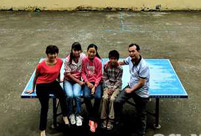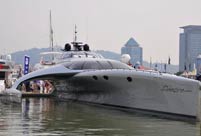China's Dalian Commodity Exchange on Friday will launch the country's first iron ore futures with physical delivery, to gain more pricing power on the commodity.
Chinese steel makers are the world's biggest iron ore buyers. Volatile iron ore prices have exposed steel makers to risks.
Chinese steel makers suffered losses from volatile iron ore prices and futures provide hedging tools for domestic steel makers and spot traders, said Zhang Yichen, an analyst with Yongan Futures Research Academy. The futures also help Chinese steel makers gain pricing power.
Physical delivery will be completed with imported iron ore powder which contains 62 percent iron as trading object, or both refined iron ore powder and iron ore concentrates with iron above 60 percent as replacements, said a statement on the bourse's website.
The trade will use stockpiles at ports including Tianjin, Lianyungang, Rizhao, Tangshan, Qingdao and Caofeidian, as well as stockpiles in some steel mills, the statement said.
The size of each lot will be 100 tonnes, have a daily trading limit of 4 percent and be denominated in yuan, the statement said.
Dalian, a seaside resort in northeast China's Liaoning Province, is home to one of China's four futures exchanges and mainly trades agricultural products. The securities regulator announced the plan on Oct. 11 and the bourse confirmed on Oct. 14.
Iron ore is the most important raw material for steel production, with Australia, China, Brazil and India accounting for around 80 percent of the world total output.
China is the world's second-largest iron ore producer. It reported 440 million tonnes in output, 740 million tonnes in imports and 1.05 billion tonnes in consumption last year.
FIERCE COMPETITION
The three top iron ore miners, BHP Billiton, Vale and Rio Tinto, scrapped annual price talks in 2009 and turned to quarterly pricing and even shorter indices or spot pricing, pointing to huge hedging opportunities.
The Chicago Mercantile and Singapore ExchangEs have traded swap options since 2011; the Indian and Singapore Commodity Exchanges launched iron ore futures in 2011; the Chicago Mercantile Exchange launched them in 2013; the Intercontinental Exchange and the London Metal Exchange announced iron ore futures in 2013.
CHINA'S RESPONSES
Chinese steel makers have questioned use of the Platts index as a benchmark: 80 to 90 percent of the production of the three top iron ore producers follows the Platts index in pricing, and the index is based on the tender prices of the three major producers.
The transparency of Platts index has been widely questioned, and further research is needed to see whether it is manipulated, according to Wang Yingsheng, director of the China Iron and Steel Association Market Research Department.
Many Chinese producers believed the iron ore index futures rely too heavily on the index, leading to control by the mining companies over the market.
Physical delivery greatly reduces the chance for the major players to manipulate market. It brings futures closer to the spot price, and better reflects supply and demand in the spot market.
All the iron ore futures contracts in the global market are iron ore index futures, lacking support in spot markets.
China, as the world's largest iron ore importer, has great spot markets and can launch iron ore futures backed by physical delivery.
The iron ore contract widens China's already existing hedging tools consisting of rebar, coal and coke contracts.
China started its own spot trading platform in March last year.
 No news of survivors in Lao Airlines crash
No news of survivors in Lao Airlines crash China's destroyer Qingdao sails out of Sydney Harbor
China's destroyer Qingdao sails out of Sydney Harbor Chinese tycoon aims to restore London's Crystal Palace
Chinese tycoon aims to restore London's Crystal Palace Admirers to bid joyful goodbye to Rubber Duck
Admirers to bid joyful goodbye to Rubber Duck Photo story: For the last three students
Photo story: For the last three students  Photo story: A day in the life of a car model
Photo story: A day in the life of a car model Chinese screen goddesses from Beijing Film Academy
Chinese screen goddesses from Beijing Film Academy  Weekly Sports Photos
Weekly Sports Photos World's most amazing yacht on display in Guangzhou
World's most amazing yacht on display in Guangzhou Photo collection of Chinese Navy
Photo collection of Chinese Navy Cold air sweeps through N China
Cold air sweeps through N China The last family in shantytowns
The last family in shantytowns UNESCO world heritage site: Montale Tower
UNESCO world heritage site: Montale Tower U.S. Senate leader announces bipartisan deal
U.S. Senate leader announces bipartisan deal Fiber-optic wedding dress show shinning in Suzhou
Fiber-optic wedding dress show shinning in Suzhou Day|Week|Month